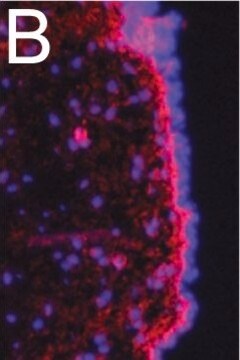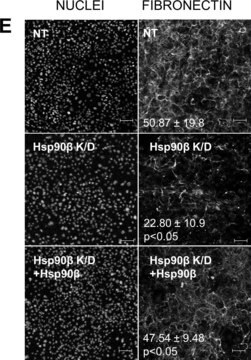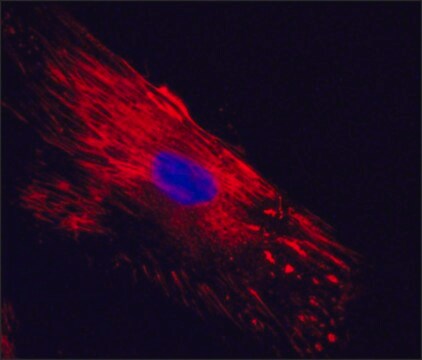AB2033
Anti-Fibronectin Antibody
CHEMICON®, rabbit polyclonal
Synonim(y):
Anti-CIG, Anti-ED-B, Anti-LETS, Anti-MSF, Anty-FINC, Anty-FN, Anty-FNZ, Anty-GFND, Anty-GFND2, Anty-SMDCF
About This Item
Polecane produkty
Nazwa produktu
Anti-Fibronectin Antibody, Chemicon®, from rabbit
pochodzenie biologiczne
rabbit
Poziom jakości
forma przeciwciała
affinity purified immunoglobulin
rodzaj przeciwciała
primary antibodies
klon
polyclonal
oczyszczone przez
affinity chromatography
reaktywność gatunkowa
mouse
producent / nazwa handlowa
Chemicon®
metody
ELISA: suitable
immunocytochemistry: suitable
immunohistochemistry: suitable
radioimmunoassay: suitable
numer dostępu NCBI
numer dostępu UniProt
Warunki transportu
dry ice
docelowa modyfikacja potranslacyjna
unmodified
informacje o genach
mouse ... Fn1(14268)
Opis ogólny
Specyficzność
Immunogen
Zastosowanie
1:80 dilution of a previous lot was used in immunofluorescent staining of frozen mouse skin and liver tissues.
Radioimmunoassay:
A previous lot of this antibody was used in RIA.
ELISA:
A 1:200 dilution of a previous lot was used in ELISA.
Optimal working dilutions must be determined by the end user.
Cell Structure
ECM Proteins
Jakość
Immunocytochemistry:
Representative image from a previous lot.
Confocal fluorescent analysis of NIH/3T3 using AB2033 rabbit polyclonal antibody (Red). Actin filaments have been labeled with AlexaFluor 488 -Phalloidin (Green). Nucleus is stained with DAPI (Blue).
Postać fizyczna
Przechowywanie i stabilność
Komentarz do analizy
Extracellular matrix in most tissue
Inne uwagi
Informacje prawne
Oświadczenie o zrzeczeniu się odpowiedzialności
Nie możesz znaleźć właściwego produktu?
Wypróbuj nasz Narzędzie selektora produktów.
Kod klasy składowania
12 - Non Combustible Liquids
Klasa zagrożenia wodnego (WGK)
WGK 1
Temperatura zapłonu (°F)
Not applicable
Temperatura zapłonu (°C)
Not applicable
Certyfikaty analizy (CoA)
Poszukaj Certyfikaty analizy (CoA), wpisując numer partii/serii produktów. Numery serii i partii można znaleźć na etykiecie produktu po słowach „seria” lub „partia”.
Masz już ten produkt?
Dokumenty związane z niedawno zakupionymi produktami zostały zamieszczone w Bibliotece dokumentów.
Nasz zespół naukowców ma doświadczenie we wszystkich obszarach badań, w tym w naukach przyrodniczych, materiałoznawstwie, syntezie chemicznej, chromatografii, analityce i wielu innych dziedzinach.
Skontaktuj się z zespołem ds. pomocy technicznej








